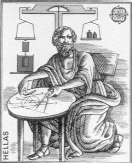| 2nd year of post-compulsory secondary education ( Natural sciences and Technology). Analysis. | |
| INDEX | |
Historically speaking, integral calculus emerged from the
need to solve the problem of finding the area of plane figures. It was
tackled by the ancient Greeks, who produced formulae to find the area
of polygons, the circle and segments of parabolas etc. They used a
method which consisted of evaluating the area of a figure exhaustively
using polygons of familiar-shaped areas. Around the XVIth century AD this method became known as the method
of Exhaustion.
In this unit we shall demonstrate this method of
exhaustion with an example. We shall then apply the same idea to
introduce intuitively the concept of the definite integral of a
function and we shall focus on some of its properties. Finally, we
shall look at the relationship between the definite integral and
finding antiderivatives. This method, originally developed by Eudoxus (406 BC - 355
BC), was used sporadically by Euclid (circa 300 BC) and systematically by
Archimedes (286 BC - 212 BC).
This method, originally developed by Eudoxus (406 BC - 355
BC), was used sporadically by Euclid (circa 300 BC) and systematically by
Archimedes (286 BC - 212 BC).
 Mathematicians of the XVIIth century (Newton, Leibniz
etc) based their work on this method and introduced the more general
concept of the definite integral of a function, f, on an interval.
This concept was later improved on by cauchy (1789-1857) and Reimann
(1826-1866).
Mathematicians of the XVIIth century (Newton, Leibniz
etc) based their work on this method and introduced the more general
concept of the definite integral of a function, f, on an interval.
This concept was later improved on by cauchy (1789-1857) and Reimann
(1826-1866).
-
To present the concept of the definite integral and its properties visually.
- The aim is not to give rigorous demonstrations but to complement explanations given in the classroom in order to help students assimilate them.


